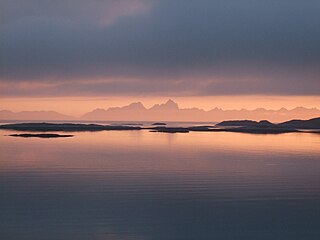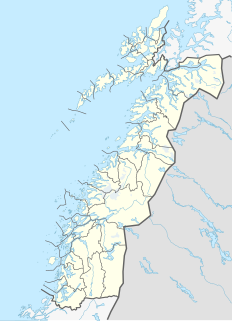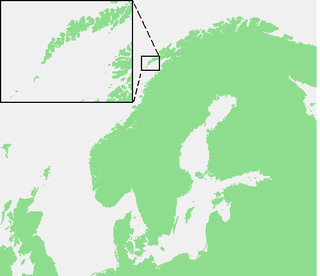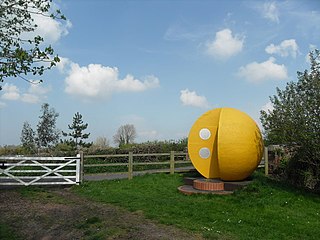
The Norwegian Sea is a marginal sea in the Atlantic Ocean, northwest of Norway between the North Sea and the Greenland Sea, adjoining the Barents Sea to the northeast. In the southwest, it is separated from the Atlantic Ocean by a submarine ridge running between Iceland and the Faroe Islands. To the north, the Jan Mayen Ridge separates it from the Greenland Sea.

A terrestrial planet, telluric planet, or rocky planet is a planet that is composed primarily of silicate rocks or metals. Within the Solar System, the terrestrial planets accepted by the IAU are the inner planets closest to the Sun, i.e. Mercury, Venus, Earth, and Mars. Among astronomers who use the geophysical definition of a planet, the Moon, Io and sometimes Europa may also be considered terrestrial planets, and so may be the large rocky protoplanet-asteroids Pallas and Vesta. The terms "terrestrial planet" and "telluric planet" are derived from Latin words for Earth, as these planets are, in terms of structure, Earth-like. These planets are located between the Sun and the asteroid belt.

A planetarium is a theatre built primarily for presenting educational and entertaining shows about astronomy and the night sky, or for training in celestial navigation.

Nordland is a county in Norway in the Northern Norway region, bordering Troms og Finnmark in the north, Trøndelag in the south, Norrbotten County in Sweden to the east, Västerbotten County to the southeast, and the Atlantic Ocean to the west. The county was formerly known as Nordlandene amt. The county administration is in the town of Bodø. The remote Arctic island of Jan Mayen has been administered from Nordland since 1995. In the southern part of the county is Vega, listed on the UNESCO World Heritage Site list.

Moskenes is a municipality in Nordland county, Norway. The municipality comprises the southern part of the island of Moskenesøya in the traditional district of Lofoten. The administrative centre of the municipality is the village of Reine. Other villages include Sørvågen, Hamnøy, and Å.

The nebular hypothesis is the most widely accepted model in the field of cosmogony to explain the formation and evolution of the Solar System. It suggests the Solar System is formed from gas and dust orbiting the Sun. The theory was developed by Immanuel Kant and published in his Universal Natural History and Theory of the Heavens (1755) and then modified in 1796 by Pierre Laplace. Originally applied to the Solar System, the process of planetary system formation is now thought to be at work throughout the universe. The widely accepted modern variant of the nebular theory is the solar nebular disk model (SNDM) or solar nebular model. It offered explanations for a variety of properties of the Solar System, including the nearly circular and coplanar orbits of the planets, and their motion in the same direction as the Sun's rotation. Some elements of the original nebular theory are echoed in modern theories of planetary formation, but most elements have been superseded.

Lofoten is an archipelago and a traditional district in the county of Nordland, Norway. Lofoten has distinctive scenery with dramatic mountains and peaks, open sea and sheltered bays, beaches and untouched lands. Its largest town, Leknes, is approximately 169 km (105 mi) inside the Arctic Circle and approximately 2,420 km (1,500 mi) away from the North Pole, making Lofoten one of the world's northernmost populated regions. Though lying within the Arctic Circle, the archipelago experiences one of the world's largest elevated temperature anomalies relative to its high latitude.

An ice giant is a giant planet composed mainly of elements heavier than hydrogen and helium, such as oxygen, carbon, nitrogen, and sulfur. There are two ice giants in the Solar System: Uranus and Neptune.
Nine Views is an ambiental installation in Zagreb, Croatia which, together with the sculpture Prizemljeno Sunce, comprises a scale model of the Solar System.

Reine is the administrative centre of Moskenes Municipality in Nordland county, Norway. The fishing village is located on the island of Moskenesøya in the Lofoten archipelago, above the Arctic Circle, about 300 kilometres (190 mi) southwest of the town of Tromsø. Reine Church is located here and it serves the northern part of the municipality.

Solar shingles, also called photovoltaic shingles, are solar panels designed to look like and function as conventional roofing materials, such as asphalt shingle or slate, while also producing electricity. Solar shingles are a type of solar energy solution known as building-integrated photovoltaics (BIPV).

Moskenesøya is an island at the southern end of the Lofoten archipelago in Nordland county, Norway. The 186-square-kilometre (72 sq mi) island is shared between Moskenes Municipality and Flakstad Municipality.

A photovoltaic system, also PV system or solar power system, is an electric power system designed to supply usable solar power by means of photovoltaics. It consists of an arrangement of several components, including solar panels to absorb and convert sunlight into electricity, a solar inverter to convert the output from direct to alternating current, as well as mounting, cabling, and other electrical accessories to set up a working system. It may also use a solar tracking system to improve the system's overall performance and include an integrated battery solution, as prices for storage devices are expected to decline. Strictly speaking, a solar array only encompasses the ensemble of solar panels, the visible part of the PV system, and does not include all the other hardware, often summarized as balance of system (BOS). As PV systems convert light directly into electricity, they are not to be confused with other solar technologies, such as concentrated solar power or solar thermal, used for heating and cooling.

Gunnar Berg was a Norwegian painter, known for his paintings of his native Lofoten. He principally painted memorable scenes of the everyday life of the local fishermen.

Henningsvær is a fishing village in Vågan Municipality in Nordland county, Norway. It is located on several small islands off the southern coast of the large island of Austvågøya in the Lofoten archipelago. The village is located about 20 kilometres (12 mi) southwest of the town of Svolvær. Henningsvær is connected to the rest of Vågan via the Henningsvær Bridges. The village is mostly located on the islands of Heimøya and Hellandsøya.
Before the scientific search for and study of extrasolar planets, the possibility was argued through philosophy and science fiction. The mediocrity principle suggests that planets like Earth should be common in the Universe, while the Rare Earth hypothesis suggests that they are extremely rare. The thousands of exoplanetary star systems discovered so far are profoundly different from the Solar system, supporting the Rare Earth Hypothesis.

The Somerset Space Walk is a sculpture trail model of the Solar System, located in Somerset, England. The model uses the towpath of the 22-kilometre (14-mile) Bridgwater and Taunton Canal to display a model of the Sun and its planets in their proportionally correct sizes and distances apart. Unusually for a Solar System model, there are two sets of planets, so that the diameter of the orbits is represented.
Jan Wanggaard is a Norwegian artist with a wide range of expressions from pure sculpture to land art in a wide sense. He was World Champion in windsurfing in 1981 and studied Art and Design in Newcastle upon Tyne, England (1983–1987).
Pøbel is the pseudonym of a Norwegian artist. His work includes paintings, photographs, sculptures, placemaking and site-specific projects. He comes from Jæren in Norway.

The Sciencenter's Sagan Planet Walk is a walkable scale model of the Solar System, located in Ithaca, New York. The model scales the entire Solar System—both planet size and distances between them—down to one five billionth of its actual size. The exhibition was originally created in 1997 in memory of Ithaca resident and Cornell Professor Carl Sagan.
















